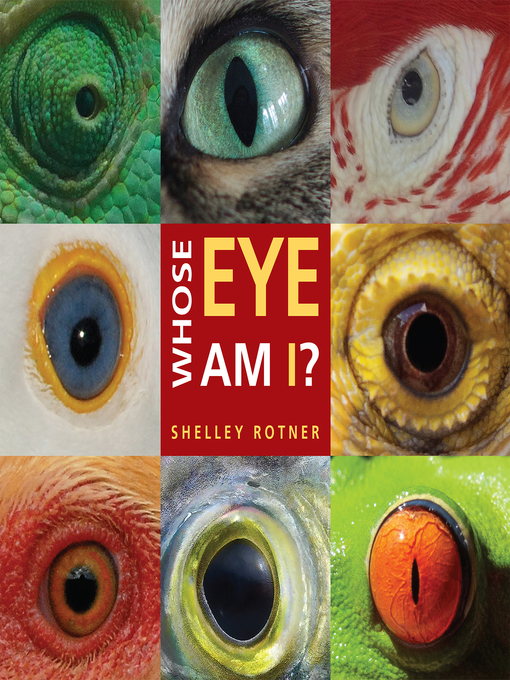- Newly Added Audiobooks
- Most Popular Audiobooks
- Try Something Different
- Audiobooks for the Whole Family
- See all audiobooks collections
-
Creators
-
Publisher
-
Release date
January 30, 2016 -
Formats
-
OverDrive Read
- ISBN: 9780823436262
-
PDF ebook
- ISBN: 9780823436262
- File size: 5826 KB
-
-
Languages
- English
-
Levels
- ATOS Level: 4.2
- Interest Level: K-3(LG)
- Text Difficulty: 2-3
-
Reviews
-
Publisher's Weekly
November 16, 2015
Rotner (Families) invites readers to identify animals—including a cat, owl, alligator, lobster, and dragonfly—by looking at close-up photographs of their eyes. After each animal’s identity is revealed, Rotner describes its visual acuity (“Bearded dragons see in full color and can see some colors that are invisible to us. Their eyes are on either side of their heads, so they see on both sides at once”) before touching on the vision of other mammals, birds, fish, and insects. The language is direct and the layout bare-bones, but the photographs are eye-catching, no pun intended, and readers will walk away with interesting tidbits about how animals, including humans, see the world. Ages 5–9. -
Kirkus
January 1, 2016
How do eyes work? Photographer Rotner uses close-ups of animal eyes to frame her discussion of this important animal feature. Her guessing game begins on the front and back covers with 16 different images of animal eyes surrounding the title question. Identifications and a thumbnail photo of each animal are provided on the flaps. These draw her young audience into her explanation of what eyes are and what they do, written in a simple but fact-filled text and plentifully illustrated with photographs. The guessing game continues with some familiar creatures: a dog, a cat, an owl, a frog, an alligator, a goldfish, a lobster, and a dragonfly. These and more are used to exemplify different attributes: eyes that see more or fewer colors than humans'; eyes designed for night vision; eye placement; eyes that move or are fixed; varying numbers of eyes and eyelids; and eyes that have one or many lenses. She concludes with a description of how humans see, a glossary defining important words, and a diagram of a human eye. The repetition of the utility of particular adaptations--eyes on the side of a head, for example--will be helpful for learning, but the appeal here is really the amazing variety in form and function. Engaging and informative for readers and listeners alike. (index) (Informational picture book. 4-8)COPYRIGHT(2016) Kirkus Reviews, ALL RIGHTS RESERVED.
-
School Library Journal
February 1, 2016
Gr 1-3-Attention-grabbing photos of animals and their eyes suffuse this volume with appeal while offering readers insight into how animals, such as eagles, newts, bumble bees, and butterflies, see and why so many different kinds of eyes have developed. Covered are motion and color blindness, long eyelashes, night vision, and extra eyelids. Pre-readers will simply study the photos; older students will enjoy the simple text that gives the animal names and explains differences. An appendix discusses human vision. VERDICT Of strong interest in most libraries for children.-Dorcas Hand, Annunciation Orthodox School, Houston, TX
Copyright 2016 School Library Journal, LLC Used with permission.
-
Booklist
January 1, 2016
Grades K-3 In vivid, super-close-up photos, eight animal eyes stare outward from the front cover of this playful book, and eight more from the back, all identified on the jacket flaps. Meanwhile, between the book's covers, a guessing game challenges viewers to name a series of animals (dog, cat, owl, frog, alligator, fish, lobster, or dragonfly) based only on a picture of an eye. Sometimes the question Who Am I? and its answer appear on two back-to-back pages, along with a short paragraph of information. In most cases, though, a two-page follow-up section offers information about vision in related animals. For example, the facts about dogs are followed by pictures and information related to other mammals: goats (good night vision) and elephants ( When they are sad, they actually cry tears ) as well as giraffes and zebras. The back matter includes details about the human eye, illustrated with a cutaway diagram. Featuring plenty of interesting facts and Rotner's clear, colorful photographs, this book offers an attractive introduction to animal vision.(Reprinted with permission of Booklist, copyright 2016, American Library Association.) -
The Horn Book
July 1, 2016
"Most animals need eyes to survive," and their shape, size, color, and more reflect the animal's adaptations. Readers guess which animal belongs to a photographed eye, enlarged to exclude the rest of the creature; information about how that animal (and others) sees and some essential vocabulary (pupil, cornea, lens) facilitates an understanding of eye functions. Streamlined text and colorful photos are suited to young readers.(Copyright 2016 by The Horn Book, Incorporated, Boston. All rights reserved.)
-
Formats
- OverDrive Read
- PDF ebook
subjects
Languages
- English
Levels
- ATOS Level:4.2
- Interest Level:K-3(LG)
- Text Difficulty:2-3
Loading
Why is availability limited?
×Availability can change throughout the month based on the library's budget. You can still place a hold on the title, and your hold will be automatically filled as soon as the title is available again.
The Kindle Book format for this title is not supported on:
×Read-along ebook
×The OverDrive Read format of this ebook has professional narration that plays while you read in your browser. Learn more here.





